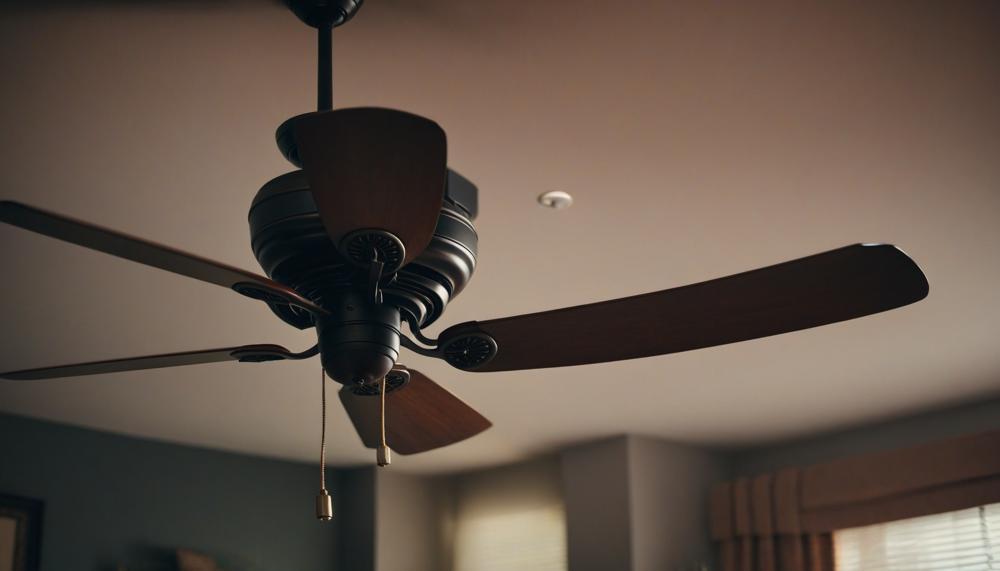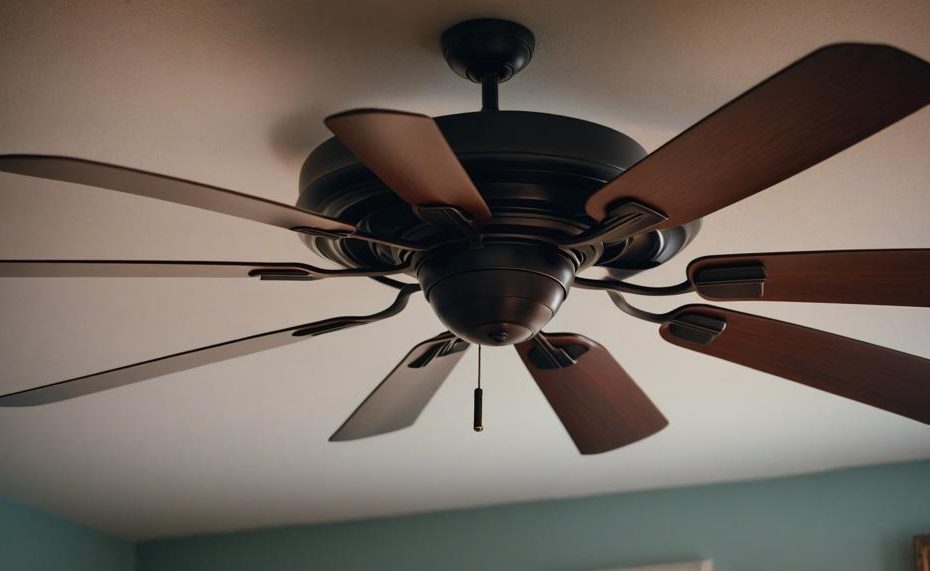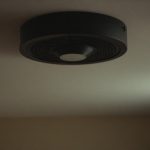Is your ceiling fan leaving you feeling a bit underwhelmed during those hot summer days? You might be surprised to learn that there are a few straightforward tweaks you can make to boost its performance significantly. To make your ceiling fan move more air and keep you cooler, here are the essential steps you should take:
- Set Your Fan to Spin Counterclockwise: Ensure your ceiling fan is set to turn counterclockwise during the summer. This direction pushes air downwards, creating a refreshing breeze.
- Upgrade the Motor Capacity: The strength of your ceiling fan’s motor is key to how much air it can move. Fans with higher motor capacity have better airflow efficiency, measured in Cubic Feet per Minute (CFM).
- Balance Blade Design and Number: More blades can improve a fan’s performance by increasing surface area. However, the motor needs to be powerful enough to handle the extra load without sacrificing efficiency.
- Optimize Speed Settings: Running your fan at higher speed settings can significantly increase the amount of air movement, but make sure the fan is designed to handle higher speeds without wobbling.
- Strategic Placement: Avoid installing your fan near corners or tall objects, as these can create airflow turbulence and reduce effectiveness. Ideally, install your fan at least 8 inches from the ceiling, 18 inches from walls or tall objects, and 9 feet from the floor.
- Regular Maintenance: Keep your ceiling fan clean and well-maintained to ensure it operates smoothly and efficiently.
By focusing on these key areas, you can transform your ceiling fan into a powerful cooling machine, making your living space much more comfortable.
Contents
- 1 Creating Airflow: The Role Of Blade Rotation
- 2 The Importance Of Blade Angle In Airflow Generation
- 3 Understanding CFM And Air Velocity For Effective Cooling
- 4 Balancing Performance And Comfort: Considering CFM And Air Velocity
- 5 Adjusting Ceiling Fan Rotation For Seasonal Airflow Effects
- 6 Optimizing Airflow: Proper Placement And Mounting Of Ceiling Fans
- 7 Conclusion
Creating Airflow: The Role Of Blade Rotation
The direction and angle of ceiling fan blades critically influence the airflow generated by the fan. When ceiling fan blades rotate counterclockwise, they push air downwards, creating a cooling breeze ideal for summer months. Conversely, in winter, blades should rotate clockwise to pull air up and circulate warm air that collects near the ceiling.
The blade angle, or pitch, determines the volume of air movement. Steeper blade angles, typically between 12 to 15 degrees, increase the amount of air displaced, enhancing cooling efficiency. Here’s a detailed breakdown:
| Factor | Impact on Airflow | Details |
| Blade Direction | Direction of airflow |
|
| Blade Angle (Pitch) | Volume of air moved |
|
| Blade Design | Efficiency and balance | Balanced and aerodynamically designed blades enhance airflow while minimizing resistance and noise. |
| Motor Capacity | Power and CFM rating | Stronger motors can handle steeper blade pitches and multiple blades, increasing the fan’s capacity to move air. |
| Installation | Optimal performance | Proper installation height and spacing from walls and ceilings prevent turbulence and ensure efficient airflow. |
Maintaining optimal blade direction and angle, combined with a strong motor and proper installation, ensures maximum airflow efficiency. Regular cleaning and maintenance are essential to keep the fan functioning effectively, enhancing both cooling and air circulation in your home.
The Importance Of Blade Angle In Airflow Generation
The blade angle of a ceiling fan significantly impacts its ability to generate airflow. This angle, often referred to as the pitch, determines how effectively the fan blades cut through the air to create circulation. Typically, an optimal blade angle ranges between 12 to 15 degrees. Here’s how different angles affect airflow:
| Blade Angle | Airflow Efficiency | Potential Issues |
| 0 Degrees | Minimal airflow | High resistance; potential motor burnout |
| 1-11 Degrees | Insufficient air movement | Blades slice through the air ineffectively |
| 12-15 Degrees | Optimal airflow | Efficient air circulation without excessive motor strain |
| 16+ Degrees | Increased airflow | Higher energy consumption; possible motor strain |
Setting the blades at a 0-degree angle meets too much resistance, leading to potential motor burnout. Conversely, blades at a lower angle (1-11 degrees) slice the air but fail to create effective air circulation. The sweet spot, usually between 12 and 15 degrees, allows the blades to move air efficiently, providing the best balance of airflow and motor longevity.
Blades set at steeper angles can increase airflow but may lead to higher energy consumption and stress on the fan’s motor.
Understanding CFM And Air Velocity For Effective Cooling
CFM (cubic feet per minute) and air velocity are critical factors determining a ceiling fan’s efficiency in cooling a room. Here’s how they impact the effectiveness of a ceiling fan:
- CFM (Cubic Feet per Minute):
- Definition: CFM measures the volume of air a fan moves per minute.
- Impact: A higher CFM rating means the fan can move more air, enhancing the cooling effect. This increased airflow helps to circulate air more effectively, reducing the perceived temperature through enhanced evaporation of sweat from the skin.
- Optimal CFM: The ideal CFM depends on room size. For example, a small room (up to 75 sq ft) might require 1,500-3,000 CFM, whereas a larger room (over 350 sq ft) might need 5,000-9,000 CFM. Energy Department Ceiling Fan Guide provides guidelines on this.
| Room Size (sq ft) | CFM Range | Effectiveness |
| Up to 75 | 1,500 – 3,000 | Basic cooling for small spaces |
| 76 – 144 | 1,600 – 4,500 | Enhanced airflow, noticeable cooling |
| 145 – 225 | 3,000 – 6,000 | Efficient cooling, suitable for average rooms |
| 226 – 400 | 4,000 – 8,000 | Optimal for large rooms, significant cooling |
| Over 400 | 5,000 – 9,000+ | Powerful cooling, ideal for very large spaces |
Key Factors Influencing CFM and Air Velocity
- Motor Capacity: A more powerful motor can increase both CFM and air velocity, providing better cooling.
- Blade Design and Number: While blade design and number affect efficiency, they do not have a direct, definitive relationship with CFM. However, optimal blade pitch (12-15 degrees) ensures effective air movement.
- Placement: Proper placement of the fan is crucial. Installing it in the center of the room at an appropriate height (7-9 feet above the floor) maximizes airflow and cooling efficiency. Incorrect placement, such as too high or in a corner, reduces effectiveness.
By understanding and optimizing CFM and air velocity, you can significantly enhance the cooling efficiency of your ceiling fan, ensuring a comfortable and pleasant environment.
Balancing Performance And Comfort: Considering CFM And Air Velocity
CFM (Cubic Feet Per Minute) and air velocity are pivotal in determining the performance and comfort of a ceiling fan.
CFM measures how much air the fan moves per minute. A higher CFM means the fan circulates more air, which translates to a stronger breeze and more effective cooling. For larger rooms, a fan with a high CFM is necessary to ensure the entire space is adequately ventilated.
Air velocity, on the other hand, refers to the speed of the airflow generated by the fan. Faster air velocity creates a wind-chill effect, making the room feel cooler without actually lowering the temperature. This can enhance comfort, especially in warm climates.
Performance and Comfort Factors:
| Factor | Impact on Performance | Impact on Comfort |
| High CFM | Ensures efficient air circulation in larger rooms | Creates a noticeable breeze, making the room feel cooler |
| High Air Velocity | Increases the wind-chill effect, enhancing perceived cooling | Provides a refreshing breeze, improving comfort |
| Fan Size | Appropriate size ensures optimal air distribution | Properly sized fans prevent hot spots and uneven cooling |
| Blade Material | Light, aerodynamic blades improve air movement | Stable, consistent airflow contributes to comfort |
Choosing a fan with both high CFM and high air velocity ensures you get the best of both worlds: efficient air movement and a cooling breeze. This balance maximises performance and comfort, turning your ceiling fan into a powerful tool for maintaining a pleasant indoor environment.
Adjusting Ceiling Fan Rotation For Seasonal Airflow Effects
Adjusting the rotation of a ceiling fan can significantly improve airflow and comfort for different seasons.
Seasonal Fan Rotation Adjustments
Summer Mode: Counterclockwise Rotation
- Effect: Directs air downwards, creating a cooling breeze.
- Purpose: Enhances the wind chill effect, making you feel cooler without changing the room temperature.
- Setting: Adjust the fan to rotate counterclockwise. This can typically be done using a switch on the fan motor housing or a remote control.
Winter Mode: Clockwise Rotation

- Effect: Pulls cool air up, pushing warm air from the ceiling down the walls.
- Purpose: Circulates warm air trapped near the ceiling, helping to distribute heat more evenly throughout the room.
- Setting: Adjust the fan to rotate clockwise. This mode is less effective for cooling but can help reduce heating costs by redistributing warm air.
Benefits of Adjusting Ceiling Fan Rotation
- Energy Efficiency: Proper fan settings reduce reliance on heating and cooling systems, potentially lowering energy bills.
- Enhanced Comfort: Optimizes room temperature by leveraging the natural airflow patterns of your fan.
- Versatility: Provides year-round utility, ensuring your ceiling fan remains a valuable asset regardless of the season.
Optimizing Airflow: Proper Placement And Mounting Of Ceiling Fans
When it comes to optimizing the airflow of a ceiling fan, several key factors need to be considered. These factors ensure that the fan operates efficiently and provides the best cooling and air circulation.
| Factor | Explanation |
| Room Size | The size of the room dictates the fan blade span. For small rooms up to 75 square feet, a fan with a 29-36 inch blade span is ideal. Larger rooms (up to 350 square feet) may require a fan with a 52-56 inch blade span. |
| Ceiling Height | For optimal airflow, the fan blades should be 8-9 feet from the floor. If your ceiling is higher, use a downrod to lower the fan to the correct height. For ceilings less than 8 feet, choose a low-profile or hugger fan. |
| Fan Location | Position the fan in the center of the room for even airflow distribution. In larger spaces, consider multiple fans. Avoid placing the fan too close to walls, as this can obstruct airflow. |
| Blade Pitch | The angle of the blades, known as blade pitch, affects how much air is moved. Blades with a pitch of 12-15 degrees provide optimal airflow without overworking the motor. |
| Obstructions | Ensure there are no obstructions such as light fixtures or beams near the fan blades, as these can impede the airflow and reduce the fan’s efficiency. |
| Mounting Options | Depending on ceiling height, choose between flush mount, standard mount, or extended downrod mount to position the fan correctly. Proper mounting ensures stability and effective operation. |
| Airflow Direction | Adjust the fan’s rotation direction seasonally: counterclockwise for summer to create a cooling breeze and clockwise for winter to distribute warm air. |
These considerations will help you maximize the performance of your ceiling fan, enhancing comfort and efficiency.
Conclusion
Boosting your ceiling fan’s airflow can transform your summer comfort without major upgrades. Start by setting your fan to spin counterclockwise to create a refreshing breeze. If your fan lacks power, upgrading to a model with a higher motor capacity will significantly improve its efficiency, measured in Cubic Feet per Minute (CFM).
Optimizing blade design is crucial—more blades can enhance performance, but only if the motor can handle them. Running your fan at higher speeds also increases airflow, but ensure it’s designed to handle these speeds without wobbling. Proper placement is vital: avoid corners and ensure adequate distance from ceilings and walls to prevent turbulence.
Regular maintenance keeps your fan operating smoothly. Keeping blades clean and ensuring the fan is well-balanced can prevent performance issues.
Understanding blade angle (pitch) and fan direction is key. A blade pitch between 12 and 15 degrees ensures optimal air movement. Adjusting the rotation direction seasonally—counterclockwise in summer and clockwise in winter—maximizes comfort by efficiently managing air circulation.





